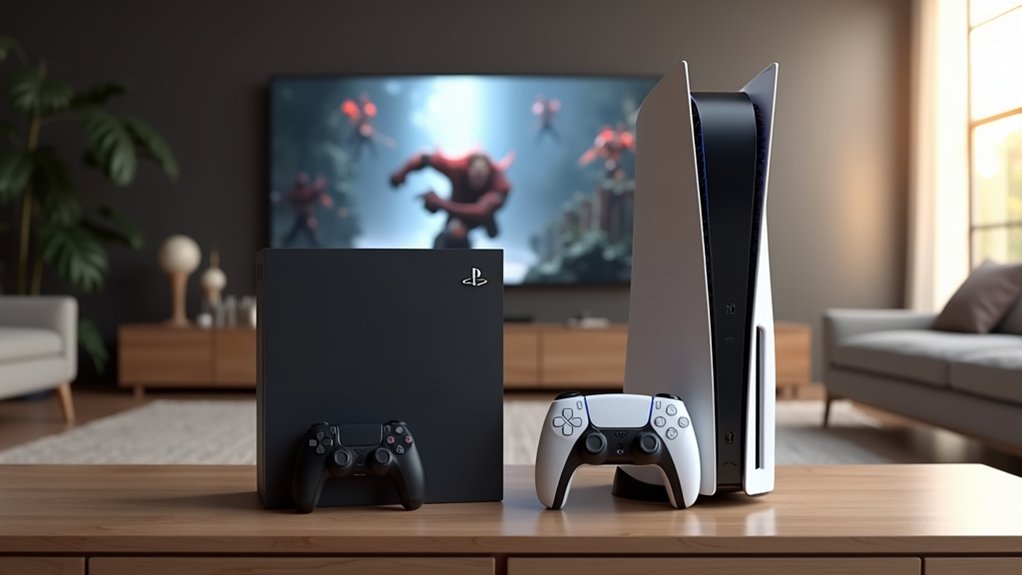
How do I add friends on Nintendo Switch
Need to add friends on Nintendo Switch? Discover simple steps and hidden tips to connect with players worldwide and enhance your gaming experience.


The PlayStation 4 and PlayStation 5 mark two very different eras of gaming. One is packed with a legendary game library at a price that still makes sense. The other? A powerhouse built for speed, visuals, and the future of play.

But when it comes down to your gaming experience, which console really fits best?
Let’s break it down.
PlayStation 4 and PlayStation 5 are two powerful Sony consoles built for gaming.
The PlayStation 4, launched in 2013, became a favorite for its vast game library and models like the original, Slim, and Pro.
The PlayStation 5, released in 2020, pushes performance further with faster load times, ray tracing, and a DualSense controller that elevates gameplay.
Whether you’re exploring epic single-player adventures or competitive multiplayer titles, both consoles deliver strong gaming experiences.
If you’re choosing between PlayStation 4 and PlayStation 5, consider your budget, desired graphics, and access to next-gen exclusives—either way, you’ll find a rich world of games to play.
Sony’s PlayStation 4 is a landmark console in gaming, offering a strong lineup of titles and dependable performance at an affordable price.
Launched in 2013, the PlayStation 4 arrived in multiple models—original, Slim, and Pro—bringing smooth 1080p gaming and a massive library of exclusive games.
While the PlayStation 4 delivers reliable gameplay and great value, it doesn’t match the PlayStation 5 in areas like graphics, speed, and next-gen features, making it ideal for gamers who want quality games without the higher cost of newer hardware.
The PlayStation 5 (PS5) is Sony’s next-generation console built to deliver faster performance and more immersive gameplay.
Launched in 2020, the PlayStation 5 features a custom SSD for near-instant load times, support for 4K (and up to 8K output), and a powerful CPU/GPU combo that brings games to life with smooth frame rates and detailed graphics.
The PlayStation 5 also includes the innovative DualSense controller, which enhances immersion with haptic feedback and adaptive triggers, and it offers backward compatibility with most PS4 games, making it a great upgrade for any gaming library.
The PlayStation 5 stands out with a bold, larger design and heavier build when compared to the more compact PlayStation 4, making it a noticeable upgrade for any gaming setup.
Its PlayStation 5 controller, the DualSense, brings advanced haptic feedback and adaptive triggers that deliver smoother, more immersive gameplay than the DualShock 4.
These design and build differences in the PlayStation 5 highlight Sony’s push for deeper player immersion, making it a strong choice for gamers who want cutting-edge features and next-gen performance.
The physical dimensions and weight of the PlayStation 4 and PlayStation 5 show a clear generational jump. The PS4 has a compact, flat profile and weighs around 2.8 kg, making it easy to fit into most gaming setups.
In contrast, the PS5 is larger and heavier at approximately 4.5 kg, designed to house more advanced hardware and improved cooling.
This difference in physical dimensions and weight can affect where you place your console and how portable it is—important considerations for gamers optimizing their home entertainment spaces.
If you’re comparing consoles for your next gaming upgrade, keep the physical dimensions and weight in mind to ensure the best fit for your setup.
The PS5 vs PS4 controller comparison highlights how much the gaming experience has evolved.
In this PS5 vs PS4 controller matchup, the PS5 DualSense brings major upgrades with advanced haptic feedback, adaptive triggers, and a built-in microphone, delivering more immersive and responsive gameplay.
By contrast, the PS4’s DualShock 4 relies on traditional rumble and basic inputs, missing these next-gen enhancements.
For players deciding between the two, the PS5 vs PS4 controller difference is clear: the DualSense sets a new standard for feel, feedback, and in-game interaction.
The PlayStation 5 delivers a major leap in performance thanks to its upgraded AMD Zen 2 processor and a powerful GPU with over five times the teraflops of the PS4.
For games, this means higher frame rates, better graphics, and smoother gameplay. The PS5 also doubles the memory to 16 GB and includes a custom SSD, which dramatically cuts loading times compared to the PS4’s HDD.
With these hardware improvements, the PlayStation 5 lets players jump into games faster and enjoy a more responsive experience.
If you’re into next-gen games, the PlayStation 5 is built to handle today’s biggest titles with speed and stability.
The PS5 vs PS4 comparison starts with a big leap in processing power.
While both consoles use an eight-core AMD architecture, the PS5’s Zen 2 CPU runs at up to 3.5 GHz, a major upgrade over the PS4’s Jaguar processor at 1.6 GHz.
This PS5 vs PS4 difference means faster load times, better AI, and more consistent performance in modern games.
On the graphics side, the PS5 delivers 10.28 teraflops compared to the PS4’s 1.84 teraflops, enabling richer visuals, higher frame rates, and smoother gameplay.
For gamers deciding between PS5 vs PS4, these CPU and GPU improvements translate directly into more immersive worlds and a better overall gaming experience.
When comparing PS5 vs PS4 memory and storage options, the differences are game-changing for performance and load times.
The PS5 features 16 GB of GDDR6 RAM—double the PS4’s 8 GB—allowing smoother multitasking, more detailed worlds, and better next-gen game performance.
In the PS5 vs PS4 storage debate, the PS5’s custom 825 GB SSD delivers blazing-fast data access, cutting load times dramatically, while the PS4 relies on slower 500 GB to 1 TB HDDs that can bottleneck responsiveness.
For gamers choosing between PS5 vs PS4, the upgraded RAM and SSD in the PS5 make a clear impact on speed, immersion, and overall gameplay experience.
Loading times and overall speed are key advantages that set the PS5 apart from the PS4. Thanks to the PS5’s custom SSD, loading times are dramatically reduced, delivering near-instant game launches and smooth world transitions that keep you in the action.
Combined with enhanced processing power and faster memory, the PS5 improves loading times and speed across the board, resulting in smoother gameplay, quicker responsiveness, and a better gaming experience for players upgrading from the PS4.
The PlayStation 5 offers major graphics and visual enhancements over the PS4, delivering higher resolutions and frame rates for smoother, more detailed gameplay.
With ray tracing technology, lighting, shadows, and reflections look more realistic, creating immersive game worlds.
These graphics and visual enhancements significantly elevate the overall experience on PS5, making games look sharper, more dynamic, and more lifelike.
Resolution and frame rates are key for gamers who want the best visuals and smooth performance.
On PS5, resolution can reach up to 4K with frame rates up to 120fps, delivering sharper detail and ultra-smooth motion.
By comparison, PS4 usually targets 1080p at 60fps, while PS4 Pro offers limited 4K support but generally lower frame rates than PS5.
If you care about resolution and frame rates in modern games, the PS5 provides a noticeable upgrade over previous consoles, making it the better choice for high-fidelity gaming.
Keyword used: resolution and frame rates (three times).
Ray tracing on PS5 delivers a major leap in visual quality for games, offering realistic lighting, lifelike shadows, and accurate reflections that make worlds feel truly immersive.
While the PS4 does not support ray tracing, the PS5 uses this technology to create more detailed scenes and richer environments.
For players who care about graphics and performance in games, ray tracing on PS5 means superior visual fidelity, cleaner effects, and a more engaging gameplay experience.
The PlayStation 5 delivers major upgrades in speed, graphics, and innovative features, making it ideal for gamers who want cutting-edge performance and immersive experiences. The PlayStation 4, on the other hand, offers a massive game library, solid performance, and a lower price, which is great for casual gamers and anyone building a budget-friendly setup. When choosing between the PlayStation 4 and PlayStation 5, consider your budget, the types of games you play, and whether you value next-gen features like faster load times, ray tracing, and DualSense haptics.

Need to add friends on Nintendo Switch? Discover simple steps and hidden tips to connect with players worldwide and enhance your gaming experience.

Properly deleting games on Nintendo Switch frees up space and keeps your system organized; discover the simple steps to manage your library efficiently.

Master the art of charging your Nintendo Switch controller efficiently—discover essential tips and tricks to keep your gameplay uninterrupted and your device ready.

Discover the best methods to safely and efficiently charge your Nintendo Switch—avoid common mistakes that could shorten your battery’s lifespan.

Getting your Nintendo Switch on the big screen is easier than you think, but there’s one crucial step you don’t want to miss.

Unlock the world of Nintendo games by creating your own account—discover the simple steps and essential tips to get started today.